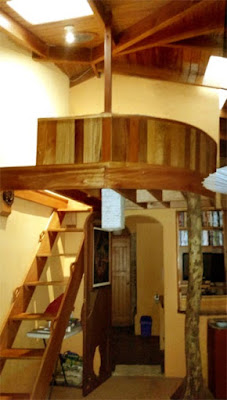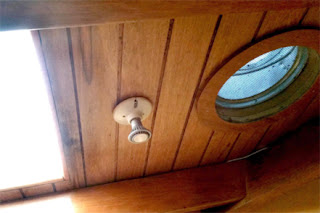Many artists have fantastic studios -- huge, lots of storage
and workspace, marvelous lighting, a place for everything. I had a pretty nice one myself not so long ago. But when I built my earthbag house in the jungle in Belize, an art studio
didn’t seem important – my whole house could be my studio, I thought. '
But when I started “being an artist again” last
November, I began yearning for a specific place to leave projects out, where they wouldn’t be in the way.
 The only place I could find to
set up even a tiny space permanently was my loft, and it was already in use
storing empty suitcases, Christmas ornaments, off-season clothes, and similar
odds and ends. But it would have to do, so I set to work.
The only place I could find to
set up even a tiny space permanently was my loft, and it was already in use
storing empty suitcases, Christmas ornaments, off-season clothes, and similar
odds and ends. But it would have to do, so I set to work.
 The only place I could find to
set up even a tiny space permanently was my loft, and it was already in use
storing empty suitcases, Christmas ornaments, off-season clothes, and similar
odds and ends. But it would have to do, so I set to work.
The only place I could find to
set up even a tiny space permanently was my loft, and it was already in use
storing empty suitcases, Christmas ornaments, off-season clothes, and similar
odds and ends. But it would have to do, so I set to work.
MAKING ROOM: The
first problem is that it’s L.I.T.T.L.E. One wall is 7’ long, the other is 5’, and the remaining wall, 18” high, curves out
over the living room leaving a floor space looking like one fourth of an
elongated pie. A 22” wide staircase eats
up nearly two feet of floor space along the 5’ wall. Like I said, little.
But, ever hopeful, I started shifting things around. Since I
didn’t want to see my junk poking up above the 18” wall from the living room
below, I couldn’t just pile things up to the ceiling. But by stuffing all the Christmas ornaments
into an empty suitcase and consolidating some other boxes, I was able to open
up a space about 3’x4’.
SEATING: On the
veranda I had a canvas camp chair that was threatening to rip and/or collapse if
someone large or squirmy were to sit down hard in it. With care, I can get a few
months more life out of it, and it’s very comfortable – a lot better than a
stump, a rock, or the cross-legged pose I assume while out sketching in nature. It fits perfectly into the cleared space. We're on our way.
WORKSPACE: a flattened cardboard box makes a sturdy table top over a poly tub holding off-season clothes. Some 1/8” thick wall paneling cut into lapboards and table tops makes sturdy surfaces to draw or set things on. One 12”x18” piece of paneling makes a good lap board to work on – it’s lightweight, maneuverable, and fits within the arms of the chair.
 LIGHTING: a translucent
skylight directly above offers perfect diffused light in the daytime, and while I haven't used the studio yet on a hot day, there is a screened roof vent near the skylight so heat should go right up
and out – but that remains to be seen.
LIGHTING: a translucent
skylight directly above offers perfect diffused light in the daytime, and while I haven't used the studio yet on a hot day, there is a screened roof vent near the skylight so heat should go right up
and out – but that remains to be seen.At night, the spotlight that was formerly trained on my lion door (which is now under the loft) shines right onto the lap board on my lap. I may add a gooseneck lamp to shine on sketch subjects at night.
TOOLS &
SUPPLIES: My art supplies are in a
tiered artist’s toolbox which remains open and serves as storage and shelves
for watercolor pencils, ballpoint pens, water brush, rag, water can, scissors,
and a few other things I use for sketch/journaling.
Someday I may find another place for the junk, but until
then, this works fine. I know, because I sketch/journaled the tapir bone page there last week. I’ll detail that in the next blog entry.
It has some good
points, for sure. No one is going to be casually walking through, I can duck and hide if I don’t want company, and I can’t possibly complain that it is
too big to keep tidy. But best of all, I've been using it, and my only complaint is that I can't get to the door downstairs very quickly when company comes. I'd say that's a pretty minor complaint.
So if you've been thinking you don't have enough space to set up your studio, I hope this has given you some inspiration.
And just in case you are telling yourself "Well, pooh on you, I don't even have THAT much space!" take a look at the "desk" where I did about half the illustrations for my first book, America's Horses & Ponies, when I had only a bed to sit on. At night, I'd hoist it up to the ceiling so I could sleep underneath it. In the sketch below, I show it both lowered and raised. Where there's a will, there's usually a way.....
.
So if you've been thinking you don't have enough space to set up your studio, I hope this has given you some inspiration.
And just in case you are telling yourself "Well, pooh on you, I don't even have THAT much space!" take a look at the "desk" where I did about half the illustrations for my first book, America's Horses & Ponies, when I had only a bed to sit on. At night, I'd hoist it up to the ceiling so I could sleep underneath it. In the sketch below, I show it both lowered and raised. Where there's a will, there's usually a way.....



















